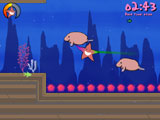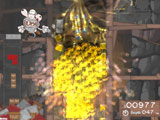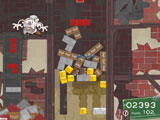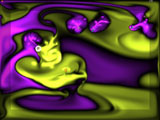The Squishiest Damn Starfish Around
Squishy the Starfish is a great student project out of Digipen. Like many student projects, it’s a little rough around the edges, but it manages to pull off a decent implementation of a neat concept. The team describes the game as:
Squishy the Starfish is a 2D side-scrolling environmental puzzle game. Making use of Squishy’s unique ability to extend his five elastic arms, the player must swing, climb, and maneuver throughout the underwater world.
Controls (Old vs. New)
While Squishy the Starfish does bring a nice twist to the genre with the five-armed starfish treatment, a swinging physics game is nothing new. The real test of a swinging game lies in the controls, though. It’s dangerous territory as a designer; the line between “novel” and “frustrating” is awfully thin. Squishy does a good job addressing some of the problems of a multi-rope swinging mechanic with its mouse-only controls.
I actually installed Squishy the Starfish months ago but just didn’t get around to reviewing it. When I sat down to play it today, I was playing that old version (and even produced a video for it). I didn’t realize there was a newer version until I went to get the link for my review. The old controls were frustrating as hell. You moved with WASD, and had to actually highlight the connected tentacle arm to adjust its length. It was touchy at best.
This version of Squishy exclusively uses the mouse, and I think that was a very wise choice. I’m especially impressed by their elegant solution for disconnecting old “ropes”. Right-click disconnects the arm farthest away from the starfish’s body. And since you move towards the mouse cursor, the farthest arm is generally the one you really want to disconnect, particularly if you’re swinging across the ceiling arm-over-arm. It’s great to see that the team was able to recognize problems with the old controls and address them.
Physics Simulation
The simulation component of Squishy the Starfish is a little twitchy. It’s always hard to pin down the “feel” of a physics engine, but something about Squishy feels too jittery. I think if the main character felt heavier, and had more dampening, it wouldn’t be so difficult to keep your momentum up. As is, it’s hard to get into the flow of smoothly navigating through the level.


(Squishy the Starfish Game Screenshots)
Free Undersea Adventures
Squishy the Starfish weighs in at three levels, so it’s really more of a portfolio piece than a game. The three levels differ in pacing and style, though. The developers did a good job embellishing their control mechanic with various props and situations. With a bit of love, Squishy could turn into a great physics platformer (well, except for the small fact that Digipen–not the students–owns the project).
Squishy is a solid implementation of a slick concept for a physics game. It’s a little unpolished, probably due to the time constraints of being a student project, but it’s a great student project. Hell, I’d hire them.
Download Squishy the Starfish Game (16.4 MB)
(Link takes you to Digipen’s gallery page, as the school prohibits redistribution).
Related Posts:
Viscous Fun in this Fluid Dynamics Physics Game
Ichor is an experimental physics game by Soylent Software. The developer’s concise description of the game does an excellent job, so I’ll just paste that:
Ichor is an action game based in fluid dynamics. Each player floats around the screen, trying to engulf his opponent with his own color.
Fluid Exchange
The beauty of Ichor is the simplicity of its structure. It immediately becomes obvious that if you touch the other color, you lose, and the goal is to cause opponents to touch your color. Basic movement keys represent the totality of the player input (mouse for single player, keyboard for two-player duels). It’s a very straightforward setup.
The actual experience of playing Ichor is much more complex, though. There are numerous strategies for “attacking” enemies. You need to be keenly aware of the fluid’s behavior. Aligning yourself upstream from an opponent and moving with a current will be much more effective than blindly bum rushing the nearest target. I found that, over time, my awareness of the fluid’s state became more complete and useful in making second-to-second decisions.
Objects to Think With
Ichor is fairly quirky, even for an indie game. I was curious about the intent of the developers, and after some research I found myself on the blog of the (sole?) developer, Namaste Reid. He makes an interesting observation about the lack of many distinct objects in the game:
In Ichor, you fight without bullets or guns. You are just there, in the fluid. Everything is subject to change at a moments notice. Compare this to games where you have units, terrain, weapons, textures, etc. These are all easily classifyable objects. I think that I can go further than Ichor, in countering object oriented gameplay, although I’m not sure it can be done with fluid dynamics alone. If it is possible, it will need to be a game where nothing isn’t fluid. I’ve been trying for a while, and have yet been unable to come up with a game design that is more purely fluid than the duel mode in Ichor.
Free, and Source Available!
Ichor’s single player game is actually rather difficult; the average game only lasts a few minutes. Still, there’s something about the game that insists you try just one more time. It’s definitely more of a high-minded experience than something like a hurt-the-ragdoll title, but if you approach it with the right mindset it can be a fun way to kill a few minutes.
Download Ichor Game (777 KB)
(be warned–the developer recommends a 3Ghz machine or faster)
The source code for Ichor and Soylent other titles are available from the Soylent Software website.
Related Posts:
When You’re Mining for Gold, and You Forget…
Blast Miner is the first game by Cryptic Sea, Alex Austin’s new company (Alex was a co-founder of Chronic Logic, makers of such fine physics games as Bridge Builder and Gish). Blast Miner is a physics-based drop puzzle game. You manipulate pieces that fall from the top of the screen; if the board fills, you lose. You score by blasting pieces of gold up from ground with massive, physics-riffic explosions. It sounds fun, even cathartic–but the implementation can be surprisingly frustrating, which is a shame, because I really want to like this game.
Gameplay Structure
The goal of Blast Miner is to set off explosions such that pieces of gold in the ground are thrust upwards, at which point they’re sucked into your gold-collecting machine. If too much other crap–TNT, dirt, cement–gets pulled into the machine instead, it breaks and you lose. Although this can happen prematurely if you aren’t careful, it generally occurs when the ground pushes up so far that the screen is completely filled, at which point it becomes completely inevitable.
Design Origins
Blast Miner is patterned after Triptych, a Chronic Logic game that played a bit like a physical Tetris. Alex confirms this in a Game Tunnel interview:
The original idea came from watching my friend Dave play Triptych, he got so good at the game he would throw the blocks around, not even bothering to stack them. So I thought it would be cool to have a game where smashing the blocks was the whole point.
Blast Miner has much faster pacing than Triptych, though. In fact, if you go back and play Triptych after playing a bit of Blast Miner, it feels downright sluggish. Blast Miner plays much, much faster. In fact, you almost have to play the game faster. This leads me to one of my biggest qualms.
Forced Play Style
One frustrating aspect with Blast Miner is that it’s actually quite difficult to get gold out of the ground. I suppose that’s proper, as gold is awfully precious. The most successful technique is to break open your gas cans to soak the ground underneath the gold. Then, if you detonate the soaked ground, the gold should shoot upwards–but only if there aren’t any explosions above the gold, which push it back down.
One way to play the game is to carefully manage the placement of all of your pieces. You can deliberately set up circumstances that will net you gold if you’re careful. The game doesn’t really support this style of play, though. The ground rises too quickly, and before long you’re swamped. The end result is a score that pales in comparison to Alex’s and Edmund’s scores on the high score list.
Thankfully, you can view the replays of any game on the online scoreboard. Watch the top players and you’ll quickly see how you should be playing. They spam pieces as quickly as possible, only occasionally slowing to take advantage of an opportune situation. There is some craft and some skill to this technique, sure, but it’s really the only valid way to play Blast Miner. And that’s a shame, because the hallmark of a great physics game is one that supports multiple play styles, without allowing any particular style to completely dominate another. Blast Miner fails this test.


(Blast Miner Game Screenshots)
Blast Away, Brave Miner
Blast Miner delivers solid physics, Edmund’s signature art style, and some variety in game modes (“super” mode with acid and time bombs and a 2-player versus mode). The game does feel a little rough around the edges, particularly with the pacing. The rewards are spaced too far apart to really get into a nice positive feedback rhythm.
Of course, it’s very easy to armchair game design. The reality is the implementation of an idea and the practical realities of development present a very complex challenge to a developer. Still, I feel like all that Blast Miner needs to shine is some iteration. If it were my game, I’d sit off-the-street players down on tape, silently observe them play the game for the first time, and then analyze the results. Rinse, repeat, and work towards something that encompasses a wider range of styles.
If your own personal play style coincides with the fast-as-possible mentality needed to succeed in Blast Miner, you should really enjoy the title. The rest of us may not be so lucky, but all physics game lovers should definitely check it out nonetheless.
Download Blast Miner Demo (10 MB)
The full version of the game is $19.95 and available from the official Blaster Miner webpage.
Related Posts:
- 2007 IGF Finalists Announced
- List of Physics Games
- Cortex Command Shaping Up!
- Defend Your Monochromatic Turret in Red
- Plasma Pong: Fluid Dynamics in a Pong Game






 My name is Matthew Wegner, and this site is dedicated to physics games.
My name is Matthew Wegner, and this site is dedicated to physics games.